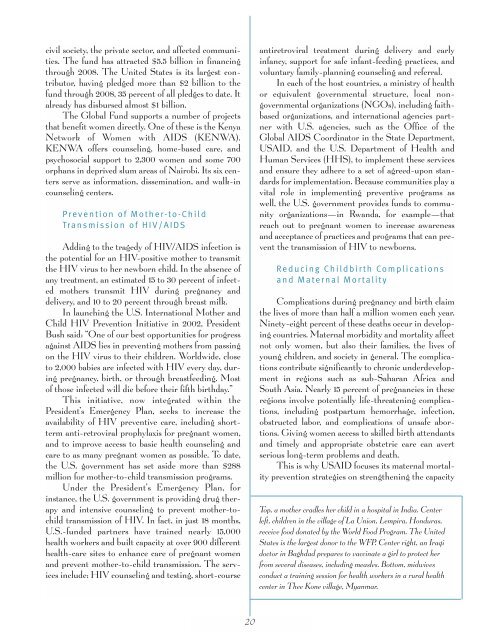Working for Women Worldwide - Embassy of the United States
Working for Women Worldwide - Embassy of the United States
Working for Women Worldwide - Embassy of the United States
Create successful ePaper yourself
Turn your PDF publications into a flip-book with our unique Google optimized e-Paper software.
civil society, <strong>the</strong> private sector, and affected communities.<br />
The fund has attracted $5.5 billion in financing<br />
through 2008. The <strong>United</strong> <strong>States</strong> is its largest contributor,<br />
having pledged more than $2 billion to <strong>the</strong><br />
fund through 2008, 35 percent <strong>of</strong> all pledges to date. It<br />
already has disbursed almost $1 billion.<br />
The Global Fund supports a number <strong>of</strong> projects<br />
that benefit women directly. One <strong>of</strong> <strong>the</strong>se is <strong>the</strong> Kenya<br />
Network <strong>of</strong> <strong>Women</strong> with AIDS (KENWA).<br />
KENWA <strong>of</strong>fers counseling, home-based care, and<br />
psychosocial support to 2,300 women and some 700<br />
orphans in deprived slum areas <strong>of</strong> Nairobi. Its six centers<br />
serve as in<strong>for</strong>mation, dissemination, and walk-in<br />
counseling centers.<br />
Prevention <strong>of</strong> Mo<strong>the</strong>r-to-Child<br />
Transmission <strong>of</strong> HIV/AIDS<br />
Adding to <strong>the</strong> tragedy <strong>of</strong> HIV/AIDS infection is<br />
<strong>the</strong> potential <strong>for</strong> an HIV-positive mo<strong>the</strong>r to transmit<br />
<strong>the</strong> HIV virus to her newborn child. In <strong>the</strong> absence <strong>of</strong><br />
any treatment, an estimated 15 to 30 percent <strong>of</strong> infected<br />
mo<strong>the</strong>rs transmit HIV during pregnancy and<br />
delivery, and 10 to 20 percent through breast milk.<br />
In launching <strong>the</strong> U.S. International Mo<strong>the</strong>r and<br />
Child HIV Prevention Initiative in 2002, President<br />
Bush said: “One <strong>of</strong> our best opportunities <strong>for</strong> progress<br />
against AIDS lies in preventing mo<strong>the</strong>rs from passing<br />
on <strong>the</strong> HIV virus to <strong>the</strong>ir children. <strong>Worldwide</strong>, close<br />
to 2,000 babies are infected with HIV every day, during<br />
pregnancy, birth, or through breastfeeding. Most<br />
<strong>of</strong> those infected will die be<strong>for</strong>e <strong>the</strong>ir fifth birthday.”<br />
This initiative, now integrated within <strong>the</strong><br />
President’s Emergency Plan, seeks to increase <strong>the</strong><br />
availability <strong>of</strong> HIV preventive care, including shortterm<br />
anti-retroviral prophylaxis <strong>for</strong> pregnant women,<br />
and to improve access to basic health counseling and<br />
care to as many pregnant women as possible. To date,<br />
<strong>the</strong> U.S. government has set aside more than $288<br />
million <strong>for</strong> mo<strong>the</strong>r-to-child transmission programs.<br />
Under <strong>the</strong> President’s Emergency Plan, <strong>for</strong><br />
instance, <strong>the</strong> U.S. government is providing drug <strong>the</strong>rapy<br />
and intensive counseling to prevent mo<strong>the</strong>r-tochild<br />
transmission <strong>of</strong> HIV. In fact, in just 18 months,<br />
U.S.-funded partners have trained nearly 15,000<br />
health workers and built capacity at over 900 different<br />
health-care sites to enhance care <strong>of</strong> pregnant women<br />
and prevent mo<strong>the</strong>r-to-child transmission. The services<br />
include: HIV counseling and testing, short-course<br />
antiretroviral treatment during delivery and early<br />
infancy, support <strong>for</strong> safe infant-feeding practices, and<br />
voluntary family-planning counseling and referral.<br />
In each <strong>of</strong> <strong>the</strong> host countries, a ministry <strong>of</strong> health<br />
or equivalent governmental structure, local nongovernmental<br />
organizations (NGOs), including faithbased<br />
organizations, and international agencies partner<br />
with U.S. agencies, such as <strong>the</strong> Office <strong>of</strong> <strong>the</strong><br />
Global AIDS Coordinator in <strong>the</strong> State Department,<br />
USAID, and <strong>the</strong> U.S. Department <strong>of</strong> Health and<br />
Human Services (HHS), to implement <strong>the</strong>se services<br />
and ensure <strong>the</strong>y adhere to a set <strong>of</strong> agreed-upon standards<br />
<strong>for</strong> implementation. Because communities play a<br />
vital role in implementing preventive programs as<br />
well, <strong>the</strong> U.S. government provides funds to community<br />
organizations—in Rwanda, <strong>for</strong> example—that<br />
reach out to pregnant women to increase awareness<br />
and acceptance <strong>of</strong> practices and programs that can prevent<br />
<strong>the</strong> transmission <strong>of</strong> HIV to newborns.<br />
Reducing Childbirth Complications<br />
and Maternal Mortality<br />
Complications during pregnancy and birth claim<br />
<strong>the</strong> lives <strong>of</strong> more than half a million women each year.<br />
Ninety-eight percent <strong>of</strong> <strong>the</strong>se deaths occur in developing<br />
countries. Maternal morbidity and mortality affect<br />
not only women, but also <strong>the</strong>ir families, <strong>the</strong> lives <strong>of</strong><br />
young children, and society in general. The complications<br />
contribute significantly to chronic underdevelopment<br />
in regions such as sub-Saharan Africa and<br />
South Asia. Nearly 15 percent <strong>of</strong> pregnancies in <strong>the</strong>se<br />
regions involve potentially life-threatening complications,<br />
including postpartum hemorrhage, infection,<br />
obstructed labor, and complications <strong>of</strong> unsafe abortions.<br />
Giving women access to skilled birth attendants<br />
and timely and appropriate obstetric care can avert<br />
serious long-term problems and death.<br />
This is why USAID focuses its maternal mortality<br />
prevention strategies on streng<strong>the</strong>ning <strong>the</strong> capacity<br />
Top, a mo<strong>the</strong>r cradles her child in a hospital in India. Center<br />
left, children in <strong>the</strong> village <strong>of</strong> La Union, Lempira, Honduras,<br />
receive food donated by <strong>the</strong> World Food Program. The <strong>United</strong><br />
<strong>States</strong> is <strong>the</strong> largest donor to <strong>the</strong> WFP. Center right, an Iraqi<br />
doctor in Baghdad prepares to vaccinate a girl to protect her<br />
from several diseases, including measles. Bottom, midwives<br />
conduct a training session <strong>for</strong> health workers in a rural health<br />
center in Thee Kone village, Myanmar.<br />
20












